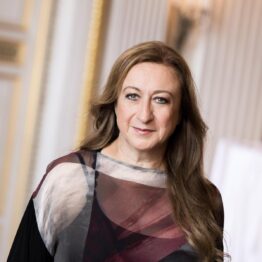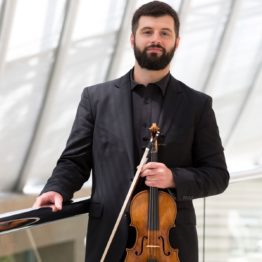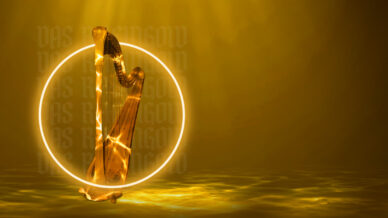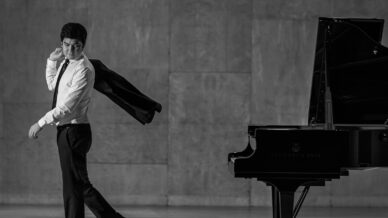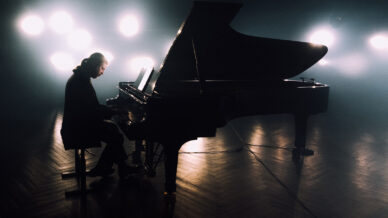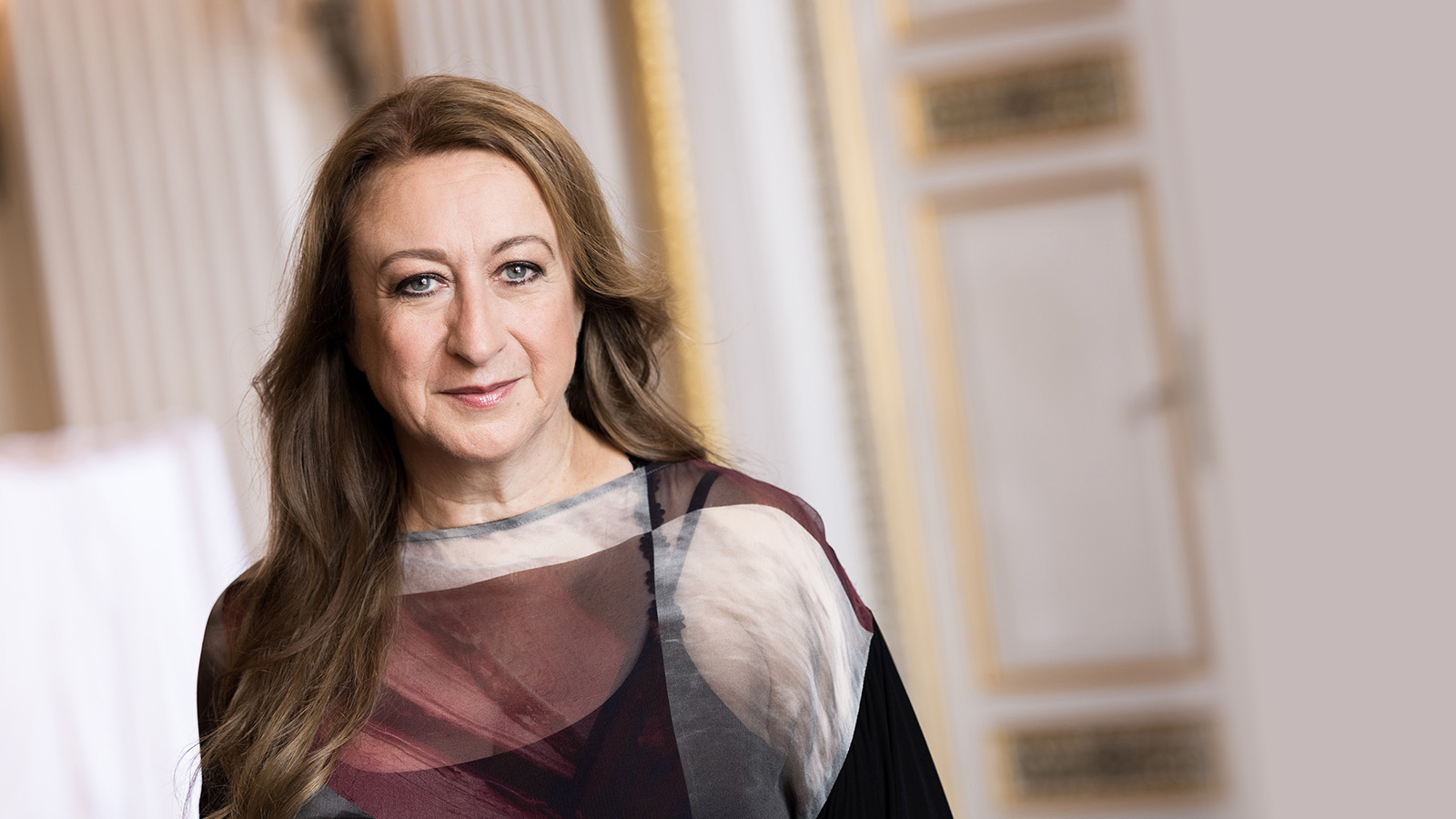

Also Sprach Zarathustra
April 11 – 14, 2024
SIMONE YOUNG conducts
NATHAN OLSON violin
ARVO PÄRT Cantus in Memoriam Benjamin Britten
BRITTEN Concerto No. 1 for Violin and Orchestra
STRAUSS Also Sprach Zarathustra (Thus Spoke Zarathustra)
STRAUSS Also Sprach Zarathustra
Millions of movie fans around the world have heard the grand fanfare from Also Sprach Zarathustra at
the beginning of Kubrick’s epic film 2001: A Space Odyssey. But if you’ve never heard it live, you’re in for a thrill — a multitude of brasses, the full orchestra, and the Lay Family Concert Organ, all hailing a primeval sunrise. To open the concert, Co-Concertmaster Nathan Olson solos in Britten’s fiendishly difficult Violin Concerto.
PERFORMANCE PRELUDES
Join us for a special pre-concert talk with Assistant Conductor Maurice Cohn! The talks will take place from Horchow Hall starting at 6:30pm on Thursday, Friday, and Saturday and 2:00pm on Sunday.

Program Notes
by René Spencer Saller
In 1935, when Arvo Pärt was born, his native Estonia was an independent Baltic state. Five years later, the Soviet Union launched an occupation that would last for the next half-century (excluding a three-year stint under German rule). Although he attended conservatory, Pärt lacked most of the advantages enjoyed by his European and American contemporaries. Aside from a few contraband scores and tapes, he was largely ignorant of all music created outside the Soviet Union. Yet somehow he managed to develop a style that was not only assured but groundbreaking.
As a student in the late 1950s and early ‘60s, Pärt adopted the neoclassicism of Bartók, Shostakovich and Prokofiev and then shifted to the serialism of Arnold Schoenberg. These stylistic experiments were banned by Soviet censors. Frustrated by political oppression and the creative constraints imposed by his predecessors’ theories, he retreated from composing and immersed himself in the study of plainsong and Gregorian chant—the sacred roots of early European polyphony. By focusing so intensely on the distant past, Pärt found an original voice: austere, tonal, liturgical and strategically simple. Commentators often classify his style as “holy minimalism” to distinguish it from the work of contemporaries such as Philip Glass and Steve Reich.
Alone With Silence
Completed in 1977, Cantus in Memoriam Benjamin Britten was written to commemorate the recent death of the titular British composer, whom Pärt believed possessed an “unusual purity.” Sadly, he never had the chance to meet Britten and had only limited exposure to his music until Pärt moved to Austria in 1980, four years after the English master had died. Cantus is an elegy for a peer who was both a stranger and a kindred spirit. It exemplifies a stylistic technique that Pärt dubbed tintinnabulation, a word that denotes the ringing of bells. “The complex and many-faceted only confuses me, and I must search for unity,” he explained. “What is it, this one thing, and how do I find my way to it? Traces of this perfect thing appear in many guises—and everything that is unimportant falls away. Tintinnabulation is like this. Here I am alone with silence. I have discovered that it is enough when a single note is beautifully played. This one note, or a silent beat, or a moment of silence, comforts me.”
Britten’s Violin Concerto is supposed to be a requiem for fallen Republican soldiers in the Spanish Civil War, but it often feels like a prescient from-the-trenches description of World War II. By the time Britten finished it, in late September of 1939, his native England had been at war for a month. Britten was in St. Jovite, Quebec, horrified and depressed by the carnage and plunder. Earlier that year, he had moved to North America, bringing with him his unfinished score for the Violin Concerto and his companion, the tenor Peter Pears, with whom he would spend the rest of his life.
Another important inspiration for the work was the Spanish violinist Antonio Brosa. Spanish-inflected rhythms and motives dominate the solo role, which is demanding on both technical and interpretive grounds. Intensely spiritual rather than explicitly religious, it’s a kind of secular lives of the saints, from Britten’s pacifist, Socialist, skeptically Modern perspective. At least 600,000 people died in the Spanish Civil War, and the good guys—the Republicans, in this case—lost to Franco and the Fascists.
Britten had also been deeply affected by the 1936 premiere performance of Alban Berg’s Violin Concerto, a requiem for 18-year-old Manon Gropius, daughter of the architect Walter Gropius and the composer and writer Alma Mahler, widow of Gustav. Berg’s brutal yet tender elegy gave Britten the idea to write a similar concerto funebre, in memory of the dead.
Year of Wonders
The year 1939 was an annus mirabilis for the violin concerto as a genre: Samuel Barber, Paul Hindemith and Walter Piston all composed major violin concertos that year. Britten was confident that his own contribution to the repertory was equal to the competition. In a letter to his publisher, he wrote, “So far it is without question my best piece. It’s rather serious, I’m afraid—but it’s got some tunes in it!”
The opening Moderato con moto begins with low timpani and cymbal. After an agitated, quasi-martial opening, a long, sensuous Mediterranean-flavored violin theme unfurls. It is overtaken by the aggressive theme before breaking free; soon, the violin and strings are entwined in a close, sweaty dance. In the final, piercing moments, the violin effuses alone against tentative pizzicato, brassy chords and rumbling timpani.
Instead of the conventional slow movement, a brisk, highly syncopated Vivace follows. This scherzo-like central movement features propulsive drum fillips, deranged twittering, scampering double-stops, lightning-fleet licks and tricky harmonics. As the movement draws to a close, a pair of piccolos and a tuba find themselves in startling colloquy before the violin’s Spanish-tinged transitional cadenza.
Trombones interrupt the end of the cadenza with the main Passacaglia theme: a scale that rises and falls in alternating whole- and half-steps. The Baroque form of passacaglia is derived from the Spanish words “pasar” and “calle”—”to walk the street.” It’s so named because of the walking bass progression, which anchors a series of thematic variations. Polyphonic intimations of J.S. Bach and perhaps Anton Bruckner abound. After the Passacaglia concludes, Britten appends a long and delicate coda derived from Moorish Andalusian folk melodies.
Strauss was a busy conductor and a prolific composer, but he always found time to read. From early adolescence until his death at 85, Strauss had a serious literature habit —Nietzsche, Wilde, Sophocles, Schopenhauer, Goethe—and his habit of choice inspired most of his greatest works. The Strauss tone poem closing this program is a response to Friedrich Nietzsche’s seminal tract Also sprach Zarathustra (Thus Spoke Zarathustra). Strauss, like Richard Wagner, Gustav Mahler and legions of European intellectuals, had fallen under the spell of the German philosopher, whose prose was a destabilizing pleasure for enervated fin-de-siècle types. Nietzsche confused and enraged hidebound moralists, but he wrote like a dream, and his perceptive music writing (on Wagner, among others) made him not so much a critic of the great composers as their peer. “To which category does my Also sprach Zarathustra belong?” asked Nietzsche. “I believe to that of the symphony!”
From Tract to Tone Poem
The son of the principal horn in the Munich Court Orchestra, Strauss began piano lessons at four. At six he started composing; his domineering, musically conservative father assisted with notation. He never enrolled in conservatory, but he received an excellent liberal arts education, with private lessons in music supplementing his studies in literature, art history, Greek, Latin, mathematics and philosophy. Before he was out of his teens, his compositions were being performed by major orchestras, including the New York Philharmonic. By his early 20s, he was conducting some of the finest orchestras in Germany and assisting the legendary Hans von Bülow, to whom he dedicated his first symphonic poem, Aus Italien.
By the time Strauss completed Also Sprach Zarathustra, in 1896, he was a confident practitioner of program music, or, as he preferred to call his compositions from this period, tone poems. This extraordinary run began a decade earlier, with Aus Italien, and included up to that point Macbeth (1887), Don Juan (1889), Tod und Verklärung (1889) and Till Eulenspiegel (1895). He conducted the premiere of Also Sprach Zarathustra on November 27, 1896, in Frankfurt.
The tone poem is divided into nine sections, played with only three pauses. Strauss named each section after chapters in Nietzsche’s text: “Introduction, or Sunrise”; ” Of Those in Backwaters”; “Of the Great Longing”; “Of Joys and Passions”; ” The Song of the Grave”; “Of Science and Learning”; “The Convalescent”; “The Dance Song”; “Song of the Night Wanderer.” It is scored for a large orchestra that includes augmented winds, glockenspiel, bell, two harps and organ.
A Closer Listen
The introductory “Sunrise” starts on a note so low that it’s nearly inaudible. Unison trumpets peal out a fanfare-like figure based on perfect intervals, vast as a distant galaxy. That indelible ditty is instantly recognizable to anyone who has seen Stanley Kubrick’s game-changing 1968 film 2001: A Space Odyssey. Richard Strauss, already dead for decades, earned thousands of new fans overnight. Elvis Presley also swiped Strauss’s famous opening fanfare to introduce his live concerts. Suddenly Strauss, who famously called himself a “first-rate second-rate composer,” was enjoying a posthumous comeback.
After the ecstatic communion with C major that closes “Sunrise,” Strauss offers the darkly lyrical “Of Those in Backwaters,” which marries bluesy cello, sepulchral double-basses, and organ pedal. “Of the Great Yearning” and “Of Joys and Passions” juggle chromaticism and lyricism. “Of Science and Learning” turns the “Sunrise” motive into an astonishing fugue. “The Convalescent” deepens and complicates the “Sunrise” fugue, culminating in a massive tutti. “The Dance Song” makes the most of a frisky solo violin and a classic Viennese waltz (in the manner of the “other” Strauss).
“Song of the Night Wander” sustains a state of deliciously dissonant Wagnerian suspension: high flutes, piccolos and violins voice a B-major chord while the low strings pluck out the very, very low C that sounded at the very outset. A major compositional obsession throughout Also Sprach Zarathrusta is the contrast between the keys of B major, symbolizing humanity and C major, symbolizing the universe. With this gesture, Strauss enacts Nietzsche’s doctrine of eternal recurrence, wherein everything happens over and over, world without end.
